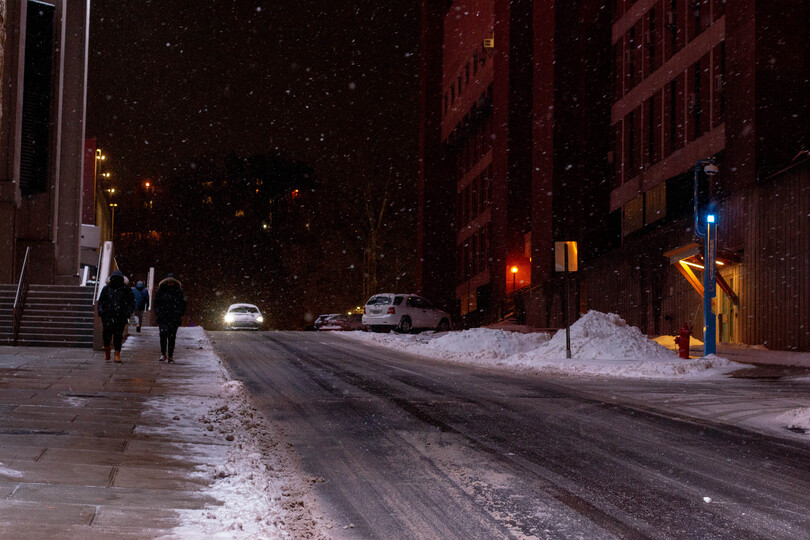Beginning to understand road salts’s impact on watersheds in Syracuse

Meghan Hendricks | Photo Editor
Water runoff flowing into Mirror Lake in the Adirondacks is measured to have nearly the same sodium level per liter of water as ocean water. Scientists say this reduces the amount of space fish have to comfortably swim in lakes.
Get the latest Syracuse news delivered right to your inbox.
Subscribe to our newsletter here.
While road salt is a useful tool for preventing slipping on the sidewalk and car accidents on the roads, its environmental impact on regional bodies of water is felt in the central New York and Adirondack regions.
“We’ve kind of had this cultural shift in the amount of road salt that we are actually applying (to the roads),” said Camille Marcotte, the water and ecology educator at the Cornell Cooperative Extension of Onondaga County. “People expect roadways to be completely clear when there’s a snowstorm, and so that led to an increase in the amount of road salt that’s been applied.”
The city of Syracuse is meeting this demand through a mobile tracking system for residents to keep tabs on where snow plows are in the city so they know what streets are cleared to drive on. The city is mitigating supply chain issues by contracting some snow removal to private businesses.
Cornell Cooperative Extension of Onondaga County hosted a webinar in February with Brendan Wiltse, the senior research scientist at Paul Smith’s College’s Adirondack Watershed Institute. A watershed is an area of land in which any precipitation is going to eventually drain to a single body of water, Marcotte said.
Wiltse explained how water runoff following snowstorms carries large amounts of road salt into watersheds and directly into local bodies of water. The elevated amount of sodium can disrupt water ecosystems and stress the organisms living there, Marcotte said.
While conducting research on Mirror Lake in Lake Placid, New York, Wiltse found that stormwater that is directed into the lake contains about 10,000 milligrams of sodium chloride per liter. Wiltse said this means the lake is being fed water that is “nearly sea water” following snowstorms. The median chloride concentration in a lake in the Adirondack mountain range is about 0.24 milligrams per liter, Wiltse added.

Maya Goosmann | Digital Design Director
This reduces the amount of dissolved oxygen in the water, and while the conditions are not lethal, it most likely puts the fish under physiological stress, Wiltse said .
Marcotte said this is an issue that plagues Skaneateles Lake, which is about 20 miles southwest of Syracuse and a primary water source for the city.
“The road salt used in Skaneateles will definitely impact Skaneateles Lake,” Marcotte said.
While there are new de-icing methods being tested for sustainability measures, like applying liquid brines instead of rock salt or the use of beet juice salt, the research is still inconclusive on how much more eco-friendly these methods are, Marcotte said.
“It’s kind of trying to figure out what’s the best way to keep our roads safe, but also reduce the environmental impact,” Marcotte said.
In October 2019, the Onondaga County Soil & Water Conservation District and Central New York Regional Planning and Development Board held an event in collaboration with New York’s Department of Transportation to calibrate municipalities’ snow plows. Part of the calibration process included making sure the trucks sprayed the right amount of salt on the roads, Marcotte said.
She would like to see municipalities continue to experiment with different plows and equipment that measures the amount of salt being applied to roads.
Another adverse effect of excess road salt application is that parts of lawns near roadways will not grow grass due to higher sodium levels in the soil, she said.
Nonetheless, there is still a significant dependence on salting roads to prepare them for snowstorms, Wiltse said. His research in the Adirondacks showed that on an annual basis 108,000 tons of road salt is applied on state roads in that region of the state, with another 84,700 tons applied on local roads.
Curtis Jetter, the New York State Department of Transportation’s public information officer, said in an email that the department calibrates all of its equipment at the beginning of the snow and ice season, and the snow plows are “calibrated routinely throughout the season to ensure (they are) applying salt at the prescribed rates.”
Marcotte recommended that residents do more on their part to clear their driveways, sidewalks and walkways with shovels and snowblowers during and immediately after storms instead of relying on copious amounts of salt.
“It’s something you can do ahead of the ice forming and after the snowstorm, go out and immediately shovel so that the snow doesn’t freeze and you’re not trying to use de-icer after that,” Marcotte said. “There’s just different things that you can do on a variety of scales to reduce the impact that road salt has.”





